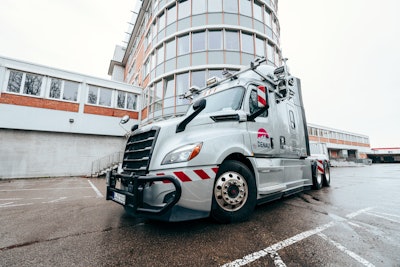
The Commercial Vehicle Safety Alliance at its Annual Conference and Exhibition in Rapid City, South Dakota, last month approved the launch of the Alliance’s "Enhanced Commercial Motor Vehicle (CMV) Inspection Program." It's an inspection standard and procedure designed to govern required inspections of trucks equipped with automated driving systems (ADS), designed to anticipate when autonomous trucks will be able to move without a human operator monitoring the system in-cab.
The "enhanced inspection procedure" is designed, said CVSA President Major Chris Nordloh of the Texas Department of Public Safety, to "ensure the highest level of safety and provide law enforcement with the information they need to be confident about the roadworthiness of autonomous trucks operating on our roadways."
The current roadside inspection/weigh station environments are challenging for ADS-equipped vehicles, CVSA said, and trucks operating themselves are not compatible with today’s roadside enforcement inspections, which rely on assistance from the driver with an officer present.
The Enhanced program substitutes certified motor carrier personnel's "point-of-origin inspections" for today's pre- and post-trip inspections conducted by the driver. It establishes a required 40-hour CVSA training course and exam for motor carrier personnel who will be conducting the inspections.

[Related: FMCSA plans to study driver involvement in autonomous trucks]
Those trained motor carrier personnel will conduct the Enhanced CMV Inspection Procedure on selected ADS-equipped vehicles from their fleets at the point of origin before dispatch, as well as in-transit inspections at a dictated interval throughout the trip.
Once on the road, the autonomous truck would be required to communicate to law enforcement while in motion that it passed the origin/destination inspection, its automated driving systems (as a whole) are functioning, and it is operating within its operational design domain. Those trucks will then be allowed to bypass fixed inspection sites.
Roadside inspections of ADS vehicles by law enforcement officials will be limited to situations where an imminent hazard is observed or during a post-crash investigation.
In addition, any fully autonomous vehicle under the new standard must be able to respond to law enforcement should an officer attempt to pull it over. Any truck or trailer or commercial motor vehicle combination that fails the Enhanced CMV Inspection Procedure at the point of dispatch must be repaired before operating.
[Related: FMCSA considering requiring electronic IDs on trucks]
The announcement of the new program, CVSA said, represents years of CVSA Enforcement and Industry Modernization Committee and Automated Vehicle Working Group meetings, discussions and development, as well as procedural testing, fine-tuning and re-testing of the new enhanced inspection program for ADS-equipped commercial motor vehicles.
CVSA added that the new program is the culmination of commercial motor vehicle inspectors and state highway patrols, inspection and enforcement experts, motor carrier representatives, the autonomous trucking development community, and federal and state government officials working together to develop inspection standards specific to the unique needs, requirements and challenges of ADS-equipped commercial motor vehicles.
[Related: Pilot working to bring autonomous truck services to truck stops]












